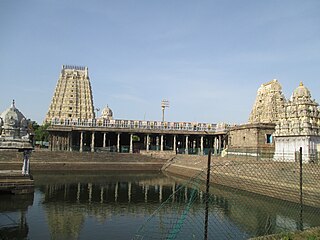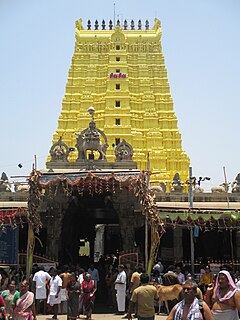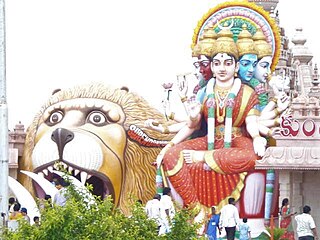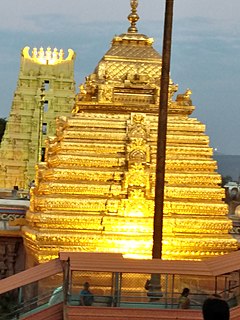
Somarama is one of the five Pancharama Kshetras that are sacred to the Hindu god Shiva. The temple is located in Bhimavaram of West Godavari district in the Indian state of Andhra Pradesh. It is one of the centrally protected monuments of national importance.

Kumararama or Bhimarama is one of the five Pancharama Kshetras that are sacred to the Hindu god Shiva. The temple is located in Samalkota of East Godavari district in the Indian state of Andhra Pradesh. The other four temples are Amararama at Amaravati(Dist. Guntur), Draksharama at Draksharama, Ksheerarama at Palakollu and Somarama at Bhimavaram(both in Dist. West Godavari). It is one of the centrally protected monuments of national importance.

Veerabhadra temple is a Hindu temple located in Lepakshi, in the state of Andhra Pradesh, India. The temple is dedicated to Virabhadra, a fierce emanation of Lord Shiva. Built in the 16th century, the architectural features of the temple are in the Vijayanagara style with profusion of carvings and paintings at almost every exposed surface of the temple. It is one of the centrally protected monumemts of national importance and is considered one of the most spectacular Vijayanagara temples. The fresco paintings are particularly detailed in very bright dresses and colours with scenes of Rama and Krishna from the epic stories of the Ramayana, the Mahabharata and the Puranas and they are well preserved. There is a very large Nandi (bull), mount of Shiva, about 200 metres (660 ft) away from the temple which is carved from a single block of stone, which is said to be one of the largest of its type in the world.

Jambukeswarar Temple, Thiruvanaikaval is a famous Shiva temple in Tiruchirapalli (Trichy) district, in the state of Tamil Nadu, India. The temple was built by Maaravarman Sundharapandi I, a pandiyan king, around 800 years ago. Though it is speculated that Kocengannan, one of the Early Cholas, to have built this temple, there is no evidence to support it. It is located in the Srirangam island, which has the famous Ranganathaswamy temple.

Ekambareswarar Temple is a Hindu temple dedicated to the deity Shiva, located in the town of Kanchipuram in Tamil Nadu, India. It is significant to the Hindu sect of Saivism as one of the temples associated with the five elements, the Pancha Bhoota Stalas, and specifically the element of earth, or Prithvi. Shiva is worshiped as Ekambareswarar or Ekambaranathar, and is represented by the lingam, with his idol referred to as Prithvi lingam. His consort Parvati is depicted as Elavarkuzhali. The presiding deity is revered in the 7th century Tamil Saiva canonical work, the Tevaram, written by Tamil saint poets known as the nayanars and classified as Paadal Petra Sthalam. The temple also houses Nilathingal Thundam Perumal temple, a Divyadesam, the 108 temples revered in the Vaishnava canon Nalayira Divya Prabhandam.

Ramanathaswamy Temple is a Hindu temple dedicated to the god Shiva located on Rameswaram island in the state of Tamil Nadu, India. It is also one of the twelve Jyotirlinga temples. It is one of the 274 Paadal Petra Sthalams, where the three of the most revered Nayanars, Appar, Sundarar and Tirugnana Sambandar, have glorified the temple with their songs. The temple was expanded during the 12th century by Pandya Dynasty, and its principal shrines sanctum were renovated by Jeyaveera Cinkaiariyan and his successor Gunaveera Cinkaiariyan of the Jaffna kingdom. The temple has the longest corridor among all Hindu temples in India. The temple is located in Rameswaram considered a holy pilgrimage site for Shaivites, Vaishnavites and Smarthas. The presiding deity, the Lingam of Ramanathaswamy (Shiva), was established and worshiped by Rama before crossing his bridge to Lanka.

Mandapa in Indian architecture, especially Hindu temple architecture, is a pillared hall or pavilion for public rituals.

Panagal or Panagallu is a historic town located 4 km from Nalgonda town in Telangana, India. Panagal was one of the capitals of Kunduru Chodas who ruled parts of eastern Telangana in the 11th and 12th centuries.
Somasila is a small village in Nellore District, Andhra Pradesh, India.

Surendrapuri is a religious tourism destination located near Hyderabad, India in the Yadadri Bhuvanagiri district. The 17-acre religious complex includes the Kunda Satyanarayana Kaladhamam - India's first mythological museum, Panchamukha Hanumadeeswara Devasthanam (Hindu temple), Navagraha temples, Nagakoti idol, and Surendrapuri’s iconic two-sided Panchamukha Hanuman-Shiva statue.

Sri Bhramaramba Mallikarjuna Temple or Srisailam Temple is a Hindu temple dedicated to the deities Shiva and Parvati, located at Srisailam in Indian state of Andhra Pradesh.

Spatika Lingam or Crystal Lingamor Crystal Shivling is a type of Lingam made from quartz. Spatika Lingam is called sphatika Sivalingam(Tamil - ஸ்படிகக்கல் லிங்கம்) ,(Telugu-స్పటిక లింగం). Sphatikam in Sanskrit means "made of crystal, crystalline", referring to quartz and alum.
Panagal Archaeological Museum is an archaeological museum located in Panagal village in Nalgonda district, Telangana, India. It is located in the premises of Pachala Someswara temple. It is also close to the Chaya Someswara temple at a distance of 1.3 km to the west of the temple.

Pachala Someswara temple is a Saivite Hindu temple located in Panagal of Nalgonda district, Telangana, India. It is a popular pilgrimage site during Maha Sivaratri. The idol of the deity here is carved out of green onyx which gives the temple its name - Pacha in Telugu means Green. The temple is in close proximity to Chaya Someswara Temple, another Saivite shrine in Panagal. The temples dates to 11th to 12th centuries CE and was probably built during the rule of Kunduru Chodas and Prataparudra I of Kakatiya Empire over the Panagal region.
Telangana State Tourism Development Corporation (TSTDC) is a state government agency which promotes tourism in Telangana, a state in the Southern region of India. The retired Director General of Police Pervaram Ramulu is the appointed First chairman of Telangana State Tourism. Tourist attractions in Telangana include historical places, monuments, forts, water falls, forests and temples.

The Culture of Telangana in India has a cultural history of about 5,000 years. The region emerged as the foremost centre of culture in Indian subcontinent during the rule of Kakatiya, the Qutb Shahi and Asaf Jahi dynasties—. The rulers' patronage and interest for arts and culture transformed Telangana into a unique multi-cultural region where two different cultures coexist together, thus making Telangana the representative of the Deccan Plateau and its heritage with Warangal and Hyderabad being its epicenter. The regions' major cultural events celebrated are "Kakatiya Festival" and Deccan Festival along with religious festivals Bonalu, Bathukamma, Dasara, Ugadi, Sankranthi, Milad un Nabi and Ramadan.

Pushpagiri Temple Complex is a temple complex located in Kadapa district in Andhra Pradesh, India. Founded around 7th Century CE, it houses some of the oldest temple congregations in the region. It is not to be confused with the Buddhist Pushpagiri Vihara ruins in Odisha.

Bugga Ramalingeswara Swamy temple is a Siva shrine situated on the southern bank of the Penna river in Tadipatri, Anantapur district of Andhra Pradesh, India. It was built between 1490 and 1509 by Ramalinga Nayudu, a chieftain of the Gutti-Gandikota region during the reign of the Vijayanagara Empire.
Tripuranthakeswara Temple is a Hindu temple dedicated to the deity Shiva, located at Tripuranthakam in Prakasam district, Andhra Pradesh, India.

Erakeswara Temple is a Saivite Hindu temple located in Pillalamarri, Suryapet district of Telangana, India. The temple was built on the banks of the Musi river in c. 1208 CE by Erakasani, the wife of Bēti Reddi of the Recherla family who were the feudatories of Kakatiyas. Erakeswara temple is one among the three prominent temples located in Pillalamarri village—the other two being Nameswara temple and Trikuta temple. The main deity of the temple is Lord Chennakesava, a form of Lord Siva.




























